 Mister Rogers may be the most iconic cardigan-wearer in pop culture history.
Mister Rogers may be the most iconic cardigan-wearer in pop culture history.The knitwear world is filled with different styles, from chunky oversized pullovers to sleek stretchy turtlenecks. While the origin of words like “turtleneck” and “pullover” seem relatively self-evident, there’s another famous sweater variety with a less straightforward name history: the cardigan.
A perfect staple for transitional weather, the term cardigan generally refers to a knitted sweater with an open front that can be buttoned up, which allows for it to be worn like a jacket over almost any outfit. Iterations of this garment have been around for centuries, but the name cardigan appears to date back to the mid-19th century. And it’s all thanks to a nobleman with the title of the Earl of Cardigan.
To explore the origins of the word cardigan and this sweater’s connection to English nobility, HuffPost spoke to a couple of fashion historians about this classic piece of knitwear and its legacy in our times.
The Origin Of The Name
“The accepted lore and history of the name ‘cardigan’ is that it comes from the Earl of Cardigan, James Thomas Brudenell, during the Crimean War where his Light Brigade was dressed in a close-fitting, knitted jacket,” fashion historian Abby Cox told HuffPost.
Indeed, the seventh Earl of Cardigan, aka Lord Cardigan, lived from 1797 to 1868 and was an officer in the British Army during the Crimean War of the 1850s. He led the famous Charge of the Light Brigade against Russian forces during the Battle of Balaclava in 1854.
In historian Robert Powyszynski Sr.’s book “The Charge of the Light Brigade,” he states that Lord Cardigan was “an arrogant and cantankerous person” who possessed a sartorial flair and spent large sums of money on new uniforms and equipment for his regiment.
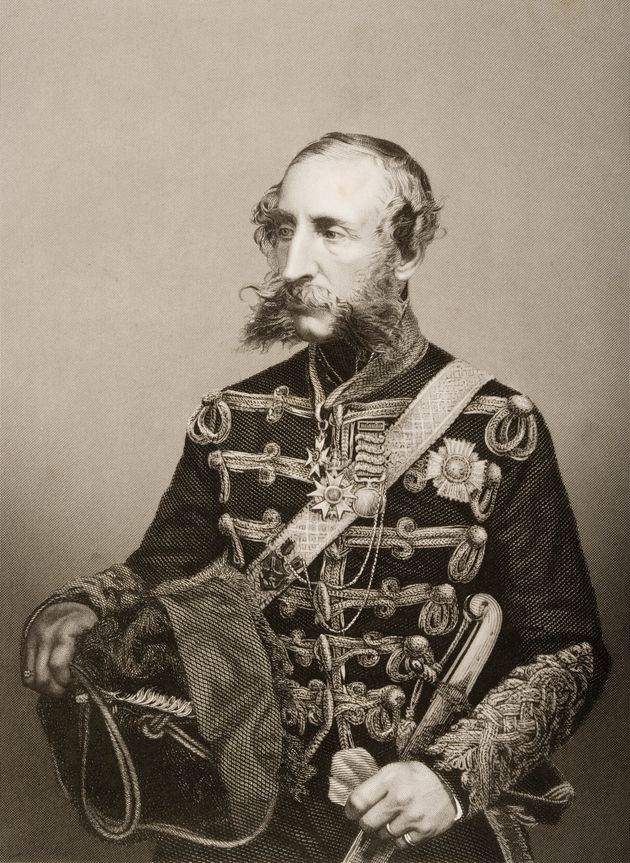 James Thomas Brudenell, 7th Earl of Cardigan, lived from 1797 to 1868 and is famous for leading the Charge of the Light Brigade during the Crimean War.
James Thomas Brudenell, 7th Earl of Cardigan, lived from 1797 to 1868 and is famous for leading the Charge of the Light Brigade during the Crimean War. “During that time he became infamous for living on a yacht harbored at the town of Balaclava and venturing onto shore to seek the company of local women,” said Keren Ben-Horin, a fashion historian, curator and co-author of “The Sweater: A History.”
Lord Cardigan was reportedly given a hero’s welcome upon his return to England after the Charge of the Light Brigade, and some say this moment of fame put his signature waistcoat or jacket style on the map. (Later accounts of the battle suggested that he actually retreated during the attack, which cast doubt on his supposed heroism.)
“It’s possible that he and other soldiers wore a type of woollen coat, but if the earl wore an actual knitted cardigan, it was more likely later in his life when he retired to the English countryside,” Ben-Horin said.
Whether or not knitted waistcoats or jackets were worn by Lord Cardigan or his regiment during the Crimean War, this type of garment came to be associated with the nobleman and thus known as a cardigan. So just as the sandwich was named for the Earl of Sandwich, the Earl of Cardigan was the guy behind this piece of sweater taxonomy.
“However, knitted jackets for men, women and children have been around for centuries, just with different names,” Cox said, sharing an example from the Los Angeles County Museum of Art’s collection dated between 1580 and 1610. “So while the name ‘cardigan’ might date back to the 1850s, the concept of the cardigan ― a knitted, long-sleeved, open-fronted garment ― has been around for centuries.”
Still, Cox noted that the earliest mention of the term cardigan in this context that she could find comes from a January 1862 edition of Godey’s Lady’s Book, which stated:
“‘The Cardigan Jacket,’ a novelty of the season, may be described as a very elastic ribbed worsted shirt, in high colours. It is intended to serve the purpose of a lady’s sacque, ‘a wrap up,’ to be worn under a coat for warmth.”
“While this snippet doesn’t explain the etymology of the term ‘cardigan,’ the date of publication does lend itself to the Earl of Cardigan and the Crimean War,” Cox said.
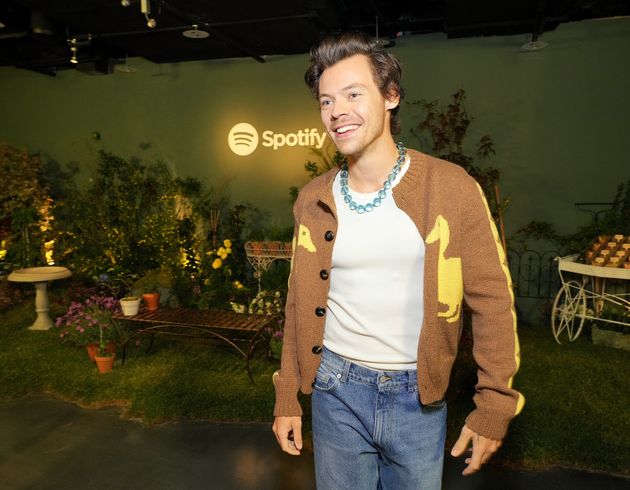 From British nobility to British pop idols: Harry Styles sported a whimsical cardigan at a Spotify album release event in May 2022.
From British nobility to British pop idols: Harry Styles sported a whimsical cardigan at a Spotify album release event in May 2022.The Rise
“Knitting at home grew in popularity during the 1800s through the 1900s, and I think that, in addition to technological advancement that allowed for more ready-made knitwear, it makes sense that knitted garments like cardigans would grow in popularity,” Cox said.
As evidenced by the ads for “cardigan jackets” that date back to the 1860s, this article of clothing quickly appeared in shops and catalogs in England and beyond. References suggest that these early cardigans may have been sleeveless, but that changed over time.
And although the term cardigan proved to have real staying power, there were other names for this style as well.
“One great example is the Columbia Book of Yarns from 1908 ― it has several different knitted jacket options for men, women, and children with names like ‘Golf Jacket,’ ‘Bryn Mawr Jacket,’ and ‘Norfolk Jacket,’” Cox said. “They all look different, but they all fit the basic definition of a cardigan ― knitted, long sleeve, and open-front garment that is secured with buttons.”
There are many reasons why the cardigan would thrive in the age of industrial manufacturing, Ben-Horin noted.
“First, the knitting frame had an almost perfect design and required very little improvement from its invention in 1589 through the early 20th century, making the production of socks, underwear and sweaters the earliest example of mechanised manufacturing,” she explained. “Second, because sweaters are created by looping only one continuous yarn, they have the ability to stretch and adjust to different body shapes, unlike tailored, woven garments that require individual adjustments to fit well, making the sweater an ideal garment for the rise of industrial, mass manufacturing.”
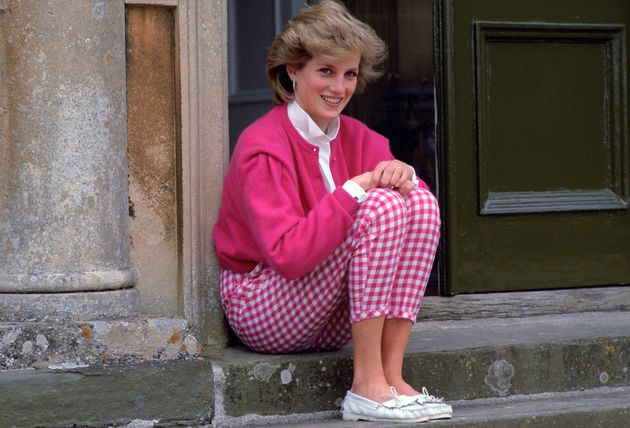 Princess Diana's iconic style featured many cozy cardigans to keep her warm in the dreary British weather. The sweater's association with Britain inspired the Swedish rock band The Cardigans' name, as its members were self-proclaimed Britophiles.
Princess Diana's iconic style featured many cozy cardigans to keep her warm in the dreary British weather. The sweater's association with Britain inspired the Swedish rock band The Cardigans' name, as its members were self-proclaimed Britophiles. She also noted that women’s clothing started to relax at the end of the 19th century, as many in the middle class started to participate in sports, attend college and otherwise engage in a more dynamic lifestyle.
“What better garment than a stretchy, practical sweater to meet the new demands of modern life?” Ben-Horin said.
Some credit Coco Chanel with popularizing cardigans for women as many of her iconic sweaters featured a button front.
“While Chanel is known for her knitwear and her fondness of British country life, where men were wearing cardigans for several decades if not centuries, she was responding to a trend rather than creating it,” Ben-Horin said.
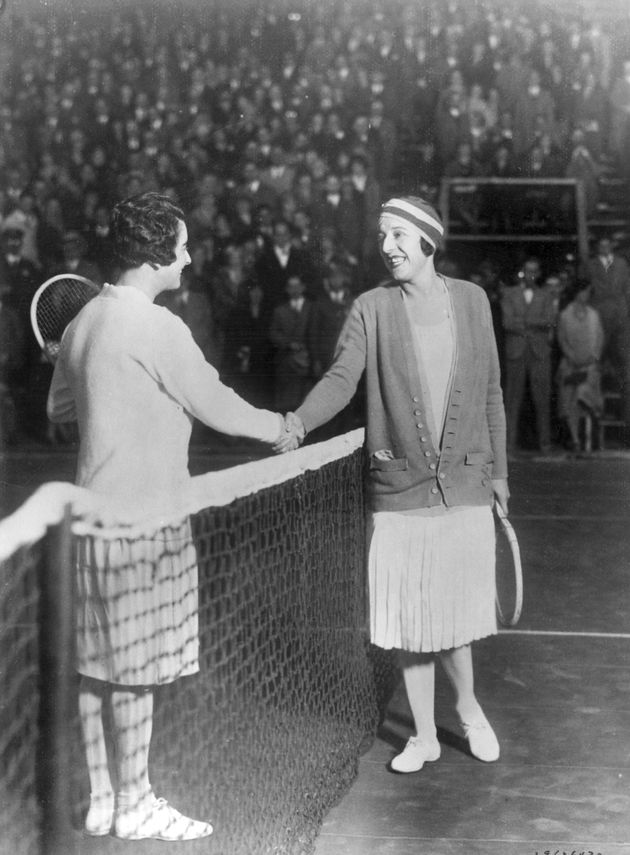 Tennis player Suzanne Lenglen (right) worked with designer Jean Patou and sported many chic cardigans on and off the court.
Tennis player Suzanne Lenglen (right) worked with designer Jean Patou and sported many chic cardigans on and off the court. She pointed to the influence of other early 20th-century designers like Elsa Schiaparelli and Jean Patou, who famously dressed tennis star Suzanne Lenglen in chic sweater outfits that allowed for ease of movement.
“By that point, cardigans were already widely worn in American colleges, the English countryside, and of course in Nordic countries where knitting has a long history,” Ben-Horin added. “In the early 1920s, even the mail order catalog of Sears, Roebuck and Co. sold fashionable cardigans ranging in price from $4.50 to $10.75. In the early 20th century, sweaters and cardigans became an important dressing category akin to athleisure today. They were associated with class and athleticism and were seen as quintessentially modern.”
Cardigans Today
“For most Americans of a certain age, the word ‘cardigan’ instantaneously evokes Mister Rogers ― a warm, fatherly figure,” Ben-Horin said. “Like most other pieces of clothing, the meaning of a cardigan changes based on who wore it, when and where, but perhaps one association prevails: There’s something intimate about a cardigan, how it envelopes the body and provides warmth.”
She recalled Kurt Cobain’s famous green cardigan that he wore during Nirvana’s 1993 appearance on “MTV Unplugged” (which sold at auction for a whopping $334,000 in 2019).
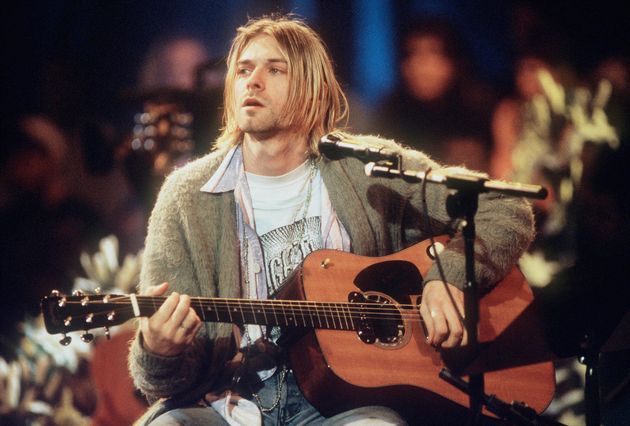 The green cardigan that Kurt Cobain wore during Nirvana's appearance on "MTV Unplugged" in 1993 has become an iconic piece of music history.
The green cardigan that Kurt Cobain wore during Nirvana's appearance on "MTV Unplugged" in 1993 has become an iconic piece of music history.“Why did this appearance on that show become so iconic?” Ben-Horin asked. “There was something vulnerable, intimate, about a grunge superstar that not only unplugs his guitar but also appears in a humble cardigan that looks like it was borrowed from his mother.”
Other iconic pop culture cardigans include receptionist Pam Beesly’s signature look on the U.S. version of “The Office,” Sandy and Danny’s respective knitwear moments in “Grease,” and The Dude’s sweater in “The Big Lebowski.” First Lady Michelle Obama was also known to sport her fair share of cardigans throughout her time in the White House, notably wearing one to meet Queen Elizabeth in 2009.
When Taylor Swift released her 2020 album “Folklore,” the lead single was “Cardigan,” which featured the lyrics:
And when I felt like I was an old cardigan / Under someone’s bed / You put me on and said I was your favourite
Accompanying the release of the album and single was a special new piece of merch: a cream-coloured cable knit cardigan like the one Swift wears in the music video for the song. Cox believes “Cardigan” nicely captures the essence of the garment.
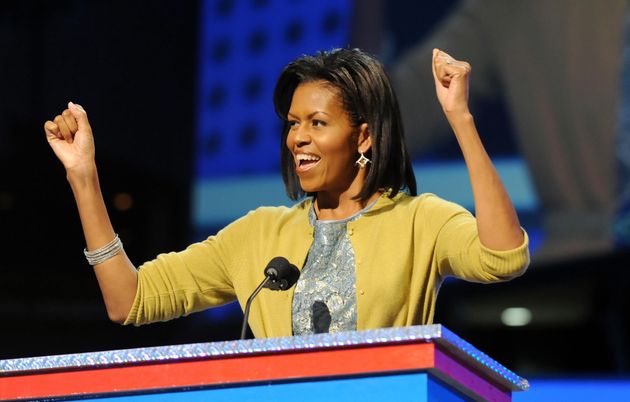 First lady Michelle Obama wore many cardigans throughout her time in the White House, starting with this mustard yellow number during the inauguration festivities in 2009.
First lady Michelle Obama wore many cardigans throughout her time in the White House, starting with this mustard yellow number during the inauguration festivities in 2009.“There is something comforting, familiar and safe about the cardigan, evoking nostalgia for a certain time like autumn, crunchy leaves, apple cider and the smell of firewood in the air, or feelings for a beloved family member,” she said. ”During the holidays, my mother wears a Christmas cardigan that was worn by my grandmother as a sort of honour to her memory. By wrapping ourselves in a cardigan we can blanket ourselves in precious memories and emotions, instilling this sense of safety and security.”
Needless to say, it makes sense that we often refer to certain styles as “grandfather cardigans” or “grandpa cardigans.” Cox said she also enjoys the TikTok discourse around the female gaze and the idea that men in cardigans epitomise sex appeal for women. However you feel about wearing or seeing cardigans in your everyday life, it’s quite clear this article of clothing is here to stay ― and has been for some time.
“I think the cardigan is a great example of how some aspects of fashion don’t really change all that much over time,” Cox said. “There are cardigans for sale today at Target that would be familiar to our great-great grandparents, which is pretty neat when you think about it.”
